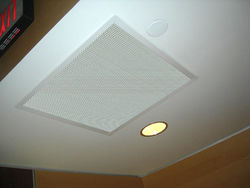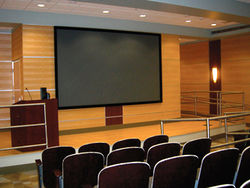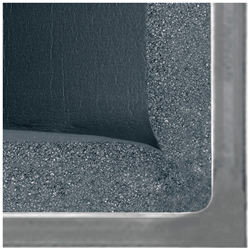Low Frequency Noises are Undesirable to Building Occupants
 Minimizing disruptive noise from a rooftop air handler unit is a common challenge faced by many building owners. A variety of measures can be employed to minimize the problem, however, insulating these systems is an ideal soundproofing measure.
Minimizing disruptive noise from a rooftop air handler unit is a common challenge faced by many building owners. A variety of measures can be employed to minimize the problem, however, insulating these systems is an ideal soundproofing measure.
Choices
In the marketplace, both fiberglass and foam are typical options from which to choose. They can equally undertake the job of reducing unwanted noise along with the thermal efficiency and energy savings they provide. The challenge is selecting a material which can deliver better results at diminishing both structure-borne and airborne noise frequencies. This is particularly important for low frequencies which are the hardest noise levels to attenuate especially around ductwork.
Low Frequency Noise Challenge
 In the case of Wesley Long Cancer Center in Greensboro, NC the noise from a rooftop air handling unit (AHU) above its 33,000 sq. ft. auditorium and classrooms was anticipated to be an issue after installation. Once an examination of the facility’s mechanical design was completed, it was determined that low to mid frequency noise (in the range of 250 to 500Hz) was likely to be the greatest problem and these frequencies are the most difficult to control. This sound annoyance was largely due to both the supply and return fans selected for the project having backward curved fan blades. When blades are curved away from the direction of rotation, they can funnel sound downward into the interior space.
In the case of Wesley Long Cancer Center in Greensboro, NC the noise from a rooftop air handling unit (AHU) above its 33,000 sq. ft. auditorium and classrooms was anticipated to be an issue after installation. Once an examination of the facility’s mechanical design was completed, it was determined that low to mid frequency noise (in the range of 250 to 500Hz) was likely to be the greatest problem and these frequencies are the most difficult to control. This sound annoyance was largely due to both the supply and return fans selected for the project having backward curved fan blades. When blades are curved away from the direction of rotation, they can funnel sound downward into the interior space.
Armacell product specialists and engineers worked closely with Stewart Acoustical, providing pertinent test data and calculating the sound attenuation per foot in relation to duct size. After much research and analysis, consultants suggested Armacell’s elastomeric foam insulation AP Coilflex® as the most suitable solution. AP Coilflex absorption of sound exceeds the minimum specification for both Type l and Type ll 1” fiberglass up to 500 Hz and is actually much better than both types of fiberglass at 500 Hz. This was exceptionally critical since the project would be submitted for LEED® Silver certification and minimizing disruptive noise is an important part of achieving the Indoor Environmental Quality (IEQ) credit in the LEED® for Healthcare New Construction and Renovations certification. The thorough investigation and documentation on the sound attenuation were crucial, for the Cancer Center’s final submission to the USGBC to achieve the LEED Silver certification but, most importantly, this investigation gave Stewart Acoustical the assurance that AP Coilflex elastomeric foam was the best solution for the project.
More Than Just Acoustics
 AP Coilflex® is a go-to solution for acoustical Engineers and consultants, particularly as facilities are increasingly concerned with Indoor Air Quality (IAQ). Many owners don’t want fibrous duct liners so they must look at other options for sound attenuation. Since AP Coilflex is fiber-free, formaldehyde-free, low in VOCs, and non-particulating, it meets many of the high IAQ standards that facilities owners either require or desire. Engineers are also becoming more careful to include anti-microbial protection as part of the specification for duct liner. AP Coilflex is made with Microban® antimicrobial protection that inhibits mold and mildew growth in the insulation for even greater assurance.
AP Coilflex® is a go-to solution for acoustical Engineers and consultants, particularly as facilities are increasingly concerned with Indoor Air Quality (IAQ). Many owners don’t want fibrous duct liners so they must look at other options for sound attenuation. Since AP Coilflex is fiber-free, formaldehyde-free, low in VOCs, and non-particulating, it meets many of the high IAQ standards that facilities owners either require or desire. Engineers are also becoming more careful to include anti-microbial protection as part of the specification for duct liner. AP Coilflex is made with Microban® antimicrobial protection that inhibits mold and mildew growth in the insulation for even greater assurance.
Less Work
To save time and labor, AP Coilflex installation is designed to be applied directly to the sheet metal duct on automated coil lines. Because it’s highly conformable, it bends neatly into the corners as the coil line machinery forms the sheet metal box. This process reduces hands on cutting and fitting labor that would be required in the field.
Click here to learn more about the Wesley Long Cancer Center Job Story.
